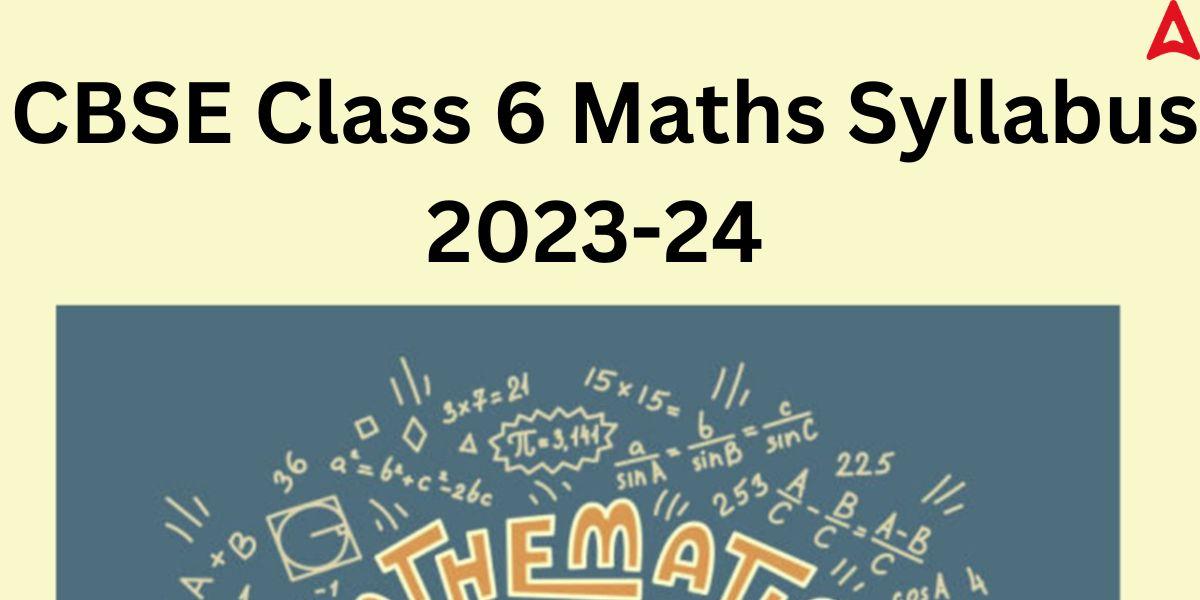CBSE Class 6 Maths Syllabus: The CBSE class 6th Maths syllabus will give students idea about the chapters and concepts that a student is required to follow in the 6th class in Mathematics subject. The CBSE board releases the Class 6 Math CBSE Syllabus in order to provide students with a high-quality education. At the start of the academic year, students can better arrange their study by identifying the curriculum. They also gain insight into the subjects on which they should concentrate more. The CBSE Class 6 Maths Syllabus is available here. The topics that students must cover in their math classes in class six are detailed in the CBSE Syllabus.
CBSE Class 6 Maths Syllabus
Math is a subject area that rewards students who understand concepts well. In order to help CBSE Class 6 pupils develop the analytical and reasoning abilities necessary for problem-solving accuracy, the CBSE has incorporated this topic in the curriculum. Students will gain a better comprehension of the topics and a clear understanding of them with the aid of the CBSE Class 6 Maths Syllabus. Using the link below, students can download the CBSE 6th Class Maths syllabus in the PDF form for the year 2023-24. Additionally, they can print it off and use it as a study guide.
CBSE Class 6 Term 1 and Term 2 Syllabus Maths 2023-24
The curriculum of the CBSE class 6th has been divided among two terms – Term 1 and Term 2. The syllabus for both term 1 and term 2 of the Maths subject is available for students in this article. The NCERT curriculum is required to be taught at schools that are connected to the Central Board of Secondary Education (CBSE). As a result, the NCERT syllabus must be followed in all classes. New high school students should carefully review the CBSE syllabus for Class 6 and adjust their exam strategy accordingly. The syllabus is revised in accordance with the most recent CBSE curriculum and NCERT recommendations.
CBSE Class 6 Maths Syllabus PDF 2023-24
The detailed syllabus of the CBSE class 6th Maths for the year 2023-24 is given below for students.
CBSE-Syllabus-for-Class-6-Maths-2023-24
CBSE Class 6 Maths Syllabus 2023-24 Units Name
The entire syllabus of the CBSE class 6th Maths syllabus is divided into 6 units. The name and sections present in those units is given hereunder.
| Unit Number | Unit Name | Section |
| 1 | Number System | Knowing Your Numbers
Playing with Numbers Whole numbers Negative Numbers and Integers Fractions |
| 2 | Algebra | Introduction to Algebra |
| 3 | Ratio and Proportion | Ratio and Proportion |
| 4 | Geometry | Basic geometrical ideas (2 -D)
Understanding Elementary Shapes (2-D and 3-D) Symmetry Constructions (using Straight edge Scale, protractor, compasses) |
| 5 | Mensuration | Concept of Perimeter and Introduction to Area |
| 6 | Data Handling | Data Handling |
CBSE Class 6 Maths Syllabus Chapters Details
The CBSE class 6 Maths NCERT contains 12 chapters in total. Each of these individual chapters are further divided into different topics. The names of the chapters and the topics that they cover are displayed in the table below. All of these chapters are included in the NCERT math textbook for class six. Since the NCERT textbook covers the full syllabus and adheres to the CBSE structure, it is advised that students study from it. Additionally, NCERT texts are used to prepare the yearly test question paper. We’ve all the important themes and sub-topics in the table below. Students should necessarily solve the back exercises of all the chapters as almost all the questions in the class 6 exam are asked from the exercises of that chapter. If students run into difficulties while working through the exercise challenges, they can consult our videos and notes available online.
| Chapters Name | Topics Name |
| Chapter 1: Knowing Our Numbers | 1.1 Introduction 1.2 Comparing Numbers 1.3 Large Numbers in Practice 1.4 Using Brackets 1.5 Roman Numerals |
| Chapter 2: Whole Numbers | 2.1 Introduction 2.2 Whole Numbers 2.3 The Number Line 2.4 Properties Of Whole Numbers 2.5 Patterns in Whole Numbers |
| Chapter 3: Playing With Numbers | 3.1 Introduction 3.2 Factors and Multiples 3.3 Prime and Composite Numbers 3.4 Test For Divisibility Of Numbers 3.5 Common Factors and Common Multiples 3.6 Some More Divisibility Rules 3.7 Prime Factorisation 3.8 Highest Common Factor 3.9 Lowest Common Multiple 3.10 Some Problems on HCF and LCM |
| Chapter 4: Basic Geometrical Ideas | 4.1 Introduction 4.2 Points 4.3 A Line Segment 4.4 A line 4.5 Intersecting Lines 4.6 Parallel Lines 4.7 Ray 4.8 Curves 4.9 Polygons 4.10 Angles 4.11 Triangles 4.12 Quadrilaterals 4.13 Circles |
| Chapter 5: Understanding Elementary Shapes | 5.1 Introduction 5.2 Measuring Line Segments 5.3 Angles-’Right’ and ‘Straight’ 5.4 Angles- ‘Acute’, ‘Obtuse’ and ‘Reflex’ 5.5 Measuring Angles 5.6 Perpendicular Lines 5.7 Classification of Triangles 5.8 Quadrilaterals 5.9 Polygons 5.10 Three Dimensional Shapes |
| Chapter 6: Integers | 6.1 Introduction 6.2 Integers 6.3 Addition of Integers 6.4 Subtraction of Integers with the help of a Number Line |
| Chapter 7: Fractions | 7.1 Introduction 7.2 A Fraction 7.3 Fraction on the Number Line 7.4 Proper Fractions 7.5 Improper and Mixed Fractions 7.6 Equivalent Fractions 7.7 Simplest Form of a Fraction 7.8 Like Fractions 7.9 Comparing Fractions 7.10 Addition and Subtraction of Fractions |
| Chapter 8: Decimals | 8.1 Introduction 8.2 Tenths 8.3 Hundredths 8.4 Comparing Decimals 8.5 Using Decimals 8.6 Addition of Numbers with Decimals 8.7 Subtraction of Decimals |
| Chapter 9: Data Handling | 9.1 Introduction 9.2 Recording Data 9.3 Organisation of Data 9.4 Pictograph 9.5 Interpretation of a Pictograph 9.6 Drawing a Pictograph 9.7 A Bar Graph |
| Chapter 10: Mensuration | 10.1 Introduction 10.2 Perimeter 10.3 Area |
| Chapter 11: Algebra | 11.1 Introduction 11.2 Matchstick Patterns 11.3 The Idea Of A Variable 11.4 More Matchstick Patterns 11.5 More Examples of Variables 11.6 Use Of Variables in Common Rules 11.7 Expressions with Variables 11.8 Using Expressions Practically 11.9 What is an Equation? 11.10 Solution of an Equation |
| Chapter 12: Ratio and Proportion | 12.1 Introduction 12.2 Ratio 12.3 Proportion 12.4 Unitary Method |
Students’ core concepts and reasoning abilities are strengthened and developed in math class six. Students in class six, the upper primary level, start to comprehend and use the mathematical language of equations and symbols. Its main goal is to help students use their comprehensive knowledge of sophisticated topics by teaching them different techniques, formulas, and theorems. As a result, it is essential that pupils comprehend every concept included in the math syllabus for class 6.










 CUET General Test Syllabus 2026 (Latest)...
CUET General Test Syllabus 2026 (Latest)...
 CUET Chemistry Syllabus 2026, Download O...
CUET Chemistry Syllabus 2026, Download O...
 CUET Agriculture Syllabus 2026, Exam Pat...
CUET Agriculture Syllabus 2026, Exam Pat...









